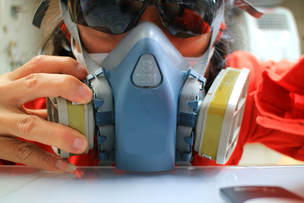 Summary In 1998 OSHA updated its respiratory standard (29CFR1910.134), this replaced the outdated 1971 standard. We're closing out 2017 and we still find confusion on the topic of respirators. Let's make this simple: Does the side of the box read "NIOSH"? Is 'NIOSH' stamped on the dust mask? If the answer is yes, it's a respirator! The standard is clear: “Filtering facepiece (dust mask) means a negative pressure particulate respirator with a filter as an integral part of the facepiece or with the entire facepiece composed of the filtering medium.”
The N95 dust-mask-style is the most common of the seven types of particulate-filtering facepiece respirators. It filters 95% of airborne particles that are .3 microns or larger, and has an assigned protection factor of 10. Half-mask-type respirators with filters have the same protection factor. Employees must be trained, medically qualified, and fit tested, to use a respirator. Under the voluntary program, the dust-mask-style respirator does not require the medical evaluation. Your employees are required to read and understand 1910.134 Appendix D. If they decide to use a half mask with filters, you are required to have your employees complete the medical evaluation (1910.134 Appendix C) and send it in to be evaluated by a Professional Licensed Health Care Provider (PLHCP). The PLHCP will determine if a physical is necessary. Understand that if your employee is not respirator-qualified, and the restriction of his breathing causes a medical emergency, you could be on the hook for the workers compensation, civil law suits, and possible OSHA citations. Complying with the standard and ensuring that your employees are using their respirators properly are not difficult. There are actions a company can take to save money. Get rid of the N95 respirators and put your employees in the half mask with filters. The typical dust-mask-style respirator will cost about $1.50 each and most employees will go through three or four per day, potentially costing you $20 a week per employee. If you buy the half mask with filters, the mask will cost about $20.00 and the filters, about $14.00 a pair. Depending on usage, if employees are trained in the proper use and storage of a respirator, the filters do not need to be changed out daily. Many times, they can be used for long periods of time. Over time it is actually more cost-effective to ditch that dust mask. Consider adding 1910.134 Appendix D as a form to be signed by all new hires. Using a dust-mask-style respirator when there are no known or potential hazards identified is considered voluntary use. Be prepared for an employee to do this without asking. We have seen employees use dust masks without management’s approval for many reasons, including simply keeping warm in the winter. A proactive signature on Appendix D may save you a citation. Best Practices
b. Are employees qualified or compliant with voluntary use? c. Are respirators properly used, cleaned, and stored? d. If it is a subcontractor, has he submitted evidence of compliance with the standard? A trained workforce is a safe and productive workforce. Safety is not something that is enforced; it is a byproduct of training. Resources OSHA FAQ OSHA 1910.134 CDC NIOSH Approved Particulate Filtering Facepiece Respirators OSHA Respiratory Protection Help educate others and prevent injuries This Safety Flash was contributed by Troy Clark, MSC Safety Solutions, in cooperation with SEAA’s Safety Committee. It is designed to keep members informed about ongoing safety issues and to provide suggestions for reducing risk. Best practices are gathered from a variety of sources. They may be more or less stringent than individual corporate policies, and are not intended to be an official recommendation from SEAA. Always get approval and direction from your company officers on any new practice or procedure as these best practices may not work for all situations. Everyone benefits when a worker avoids injury. Comments are closed.
|


 RSS Feed
RSS Feed
